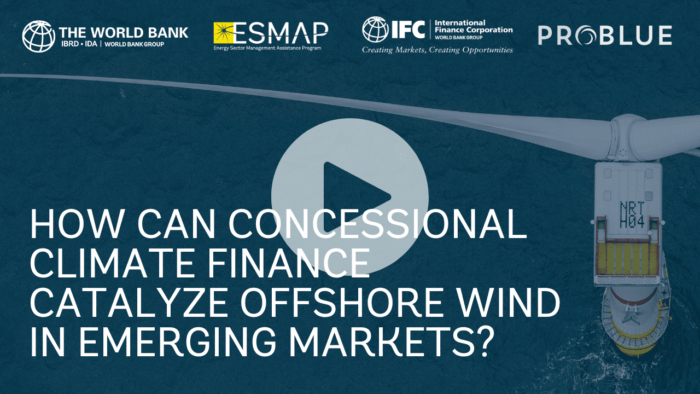Concessional Climate Finance Essential to Catalyzing Offshore Wind Development in Emerging Markets

Concessional climate financing could be the key to unlocking the immense decarbonization potential and socioeconomic benefits of offshore wind in emerging markets.
WASHINGTON – A new report published today by the World Bank’s Energy Sector Management Assistance Program (ESMAP) and the International Finance Corporation (IFC) finds that concessional climate financing is essential to unlock offshore wind in emerging markets and estimates that $15 billion in concessional climate financing, consisting of both grants and loans, could catalyze offshore wind deployment in up to ten emerging market countries.
As a large-scale, clean, reliable electricity source, offshore wind is critical to achieving global decarbonization and the sustainable development goals. Concessional climate financing for offshore wind investments, delivered through existing channels, could directly avoid 416 million metric tons (Mt) of greenhouse gas emissions over the life of the projects – equivalent to the total annual CO2 emissions of a country like Türkiye.
Gabriela Elizondo Azuela, ESMAP Manager, said: “Right now, there is the right technology, growing government ambition, and huge private sector interest to build up new offshore wind markets. But the development of offshore wind in emerging markets will not happen overnight – nor will it happen without support. Our new analysis sets a benchmark of the financing needs to unlock offshore wind’s benefits in emerging markets across the world.”
Although the cost of offshore wind has dropped dramatically over the past decade, there will be an initial cost premium when developing offshore wind in emerging markets due to a variety of risks and constraints in establishing a new market. Concessional climate finance could help countries overcome this initial cost barrier to help reduce costs for future projects and lay the foundation for the development of successful offshore wind markets.
According to the report, concessional climate financing consisting of $4.8 billion of concessional public debt, $8.3 billion of concessional private debt, and $2.5 billion in grants over an initial five-year period would enable the development of ten pathfinder projects between 500-1,000 MWs each, driving down the average Levelized Cost of Electricity (LCOE) from US$100 per megawatt-hour (MWh) to US$70 per MWh.
Jamie Fergusson, Director of IFC’s Climate Business Department said: “Everyone wins if we can kick-start offshore wind in emerging markets. For donor countries, it represents a big-ticket solution to accelerate the pace of global decarbonization, not to mention significant trade and export opportunities. For emerging markets, it would mean catalyzing economic development and creating greater energy security. Ultimately, a coordinated public and private sector response to share the burden of the initial high costs will be essential to realize these wins for everyone.”
This report is part of the World Bank’s ESMAP and IFC’s program to accelerate the deployment of offshore wind in emerging markets. The program has worked with over 24 emerging market governments providing capacity building and support for policymakers on the technical, commercial, regulatory, environmental & social aspects of offshore wind development to integrate offshore wind into their long-term energy and sustainability strategies.
Note:
- The full report is available for download here: www.esmap.org/concessional-finance-for-offshore-wind/
- For more information on the World Bank’s ESMAP and IFC’s work on offshore wind, see: www.esmap.org/offshore-wind/
- The report’s results are based on a model conducting sensitivity analysis on the expected electricity tariff for a representative offshore wind pathfinder project using various amounts of concessional finance. The model includes a base case and a series of variables used to undertake scenario analysis at different levels of CapEx and concessional debt to assess the impact on tariff, the project’s Internal Rate of Return (IRR), average rate of interest, and debt-service coverage ratio (DSCR).


